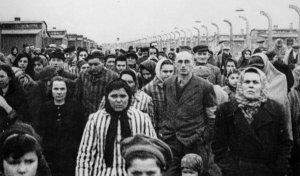
The inmates of a Polish concentration camp: shortly after the camp was overun by advancing Soviet forces and the captives were released. Note the absence of any emaciated figures here The Liberation of the Camps by Theodore J. O'Keefe
Holocaust photography
quotes
[back]
Holocaust
revisionism
See quotes: Auschwitz-Birkenau Treblinka Selected Robert Faurisson Witness evidence (false) False evidence Witness torture
See photos: Auschwitz Belsen Belzec Buchenwald Dachau Faked Propaganda

The inmates of a Polish concentration camp: shortly after the camp was
overun by advancing Soviet forces and the captives were released. Note the
absence of any emaciated figures here
The Liberation of the Camps by Theodore J. O'Keefe
Quotes
All photographs of heaps of corpses were taken in Western
camps around the end of the war, such as Dachau, Bergen-Belsen, and Buchenwald,
where historians now agree no mass murders took place. Significantly,
there are no such photographs taken at the camps in which mass murder is alleged
to have occurred (Auschwitz, Treblinka, Belzec, Sobibor, Chelmno, Majdanek.)
These eastern camps were all in areas which came under Soviet control at war's
end. It is very telling that the Soviets released no pictures of mass graves or
heaps of corpses and allowed no journalists, medical professionals, or other
experts to examine the camps. Since the end of the 1980s.
.....There is no denying that a government which
imprisons people in camps is responsible for them and so the unjustly imprisoned
were therefore victims of the Third Reich, even if they died "only" of disease.
However, one should not overlook the fact that by the war's end, mountains of
corpses had become commonplace throughout Germany. In German cities there were
600,000 victims of Allied terror bombings. Millions more died of starvation and
disease, which continued rampant through 1949. In Eastern Germany and
Czechoslovakia, three million Germans were murdered by Serbs, Czechs, Poles, and
Russians in the course of history's bloodiest ethnic cleansing. In the POW camps
of the western Allies, a million young German men died and millions more
vegetated. Hundreds of thousands more were shipped to the labor camps of the
Soviet GULag never to be seen again. But the media show only one variety of
corpse piles, those in the concentration camps. We should all ask ourselves why
this is so.
FAQ about Revisionism
by Germar Rudolf
We’ve all seen "The Photographs." Endlessly. Newsreel photos
taken by U.S. and British photographers at the liberation of the German camps,
and especially the awful scenes at Dachau, Buchenwald, and Bergen-Belsen. For
instance, look at the one at the top of this leaflet. These photos and films are
usually presented in a way in which it is either stated or implied that the
scenes resulted from deliberate German policies. The photographs are real, but
their interpretation is false.
Even mainstream historians admit
that there was no German policy at any of those camps to kill the internees. In
the last months of the war, while Soviet armies were invading Germany from the
east, British and U.S. bombers were destroying every major city in Germany with
saturation bombing. Transportation, the food distribution system, medical, and
sanitation services all broke down. That was the purpose of these air raids,
which was the most barbaric form of warfare in Europe since the Mongol invasion.
Millions of refugees fleeing the
Soviet armies were pouring into central and western Germany. As a result of the
ongoing war, of starvation, and epidemics, millions of civilians were dying all
over Germany. The camps were not exempted from this tragedy. Camps that were
still under German control were overcrowded with internees evacuated from the
east. By early 1945, these inmates suffered from malnutrition and epidemics like
typhus and cholera, to which many succumbed. When the press entered the camps
with British and U.S. soldiers, they found the results of that. They took "The
Photographs."
Still, at camps such as Buchenwald,
Dachau, and Bergen-Belsen tens of thousands of relatively healthy internees were
liberated. They were there in the camps when "The Photographs" were taken. There
are newsreels of these internees walking through the camp streets laughing and
talking. Others picture exuberant internees throwing their caps in the air and
cheering their liberators. It is only natural to ask why you haven’t seen those
particular films and photos while you’ve seen the others hundreds of times.
THE HOLOCAUST CONTROVERSY The Case For Open Debate An
Introduction by Germar Rudolf